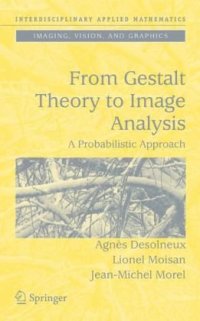
Ebook: From Gestalt theory to image analysis: a probabilistic approach
- Genre: Computers
- Tags: Partial Differential Equations, Signal Image and Speech Processing, Image Processing and Computer Vision, Visualization, Applications of Mathematics, Algorithms
- Series: Interdisciplinary applied mathematics 34
- Year: 2008
- Publisher: Springer-Verlag New York
- City: New York, NY
- Edition: 1
- Language: English
- pdf
This book introduces the reader to a recent theory in Computer Vision yielding elementary techniques to analyse digital images. These techniques are inspired from and are a mathematical formalization of the Gestalt theory. Gestalt theory, which had never been formalized is a rigorous realm of vision psychology developped between 1923 and 1975.
From the mathematical viewpoint the closest field to it is stochastic geometry, involving basic probability and statistics, in the context of image analysis.
The book is intended for a multidisciplinary audience of researchers and engineers. It is self contained in three aspects: mathematics, vision and algorithms, and requires only a background of elementary calculus and probability. A large number of illustrations, exercises and examples are included. The authors maintain a public software, MegaWave, containing implementations of most of the image analysis techniques developed in the book.
This book introduces the reader to a recent theory in Computer Vision yielding elementary techniques to analyse digital images. These techniques are inspired from and are a mathematical formalization of the Gestalt theory. Gestalt theory, which had never been formalized is a rigorous realm of vision psychology developped between 1923 and 1975. From the mathematical viewpoint the closest field to it is stochastic geometry, involving basic probability and statistics, in the context of image analysis. The authors maintain a public software, MegaWave, containing implementations of most of the image analysis techniques developped in the book.
The book is intended for researchers and engineers. It is mathematically self-contained and requires only the basic notions in probability and calculus.